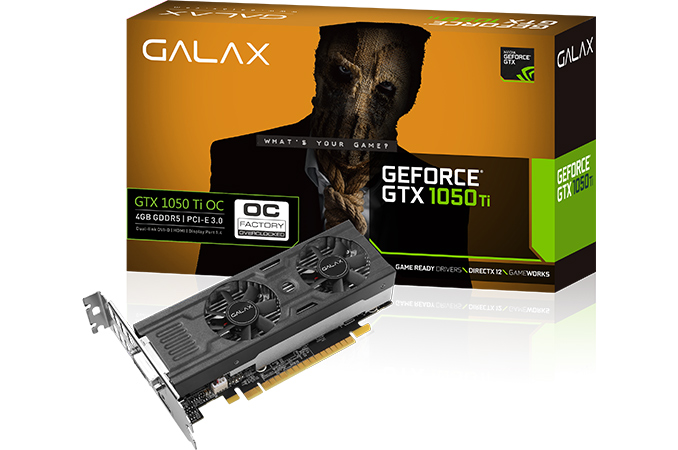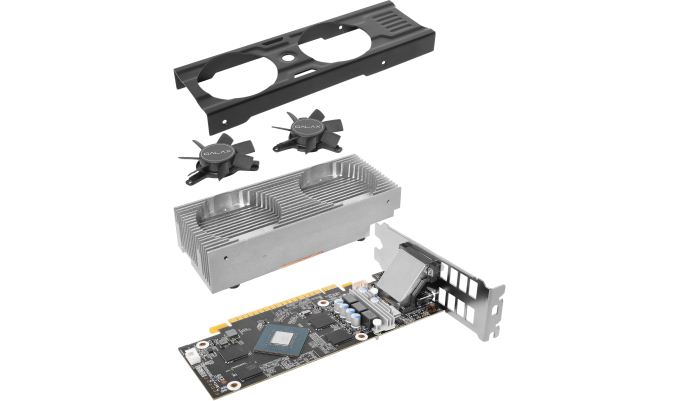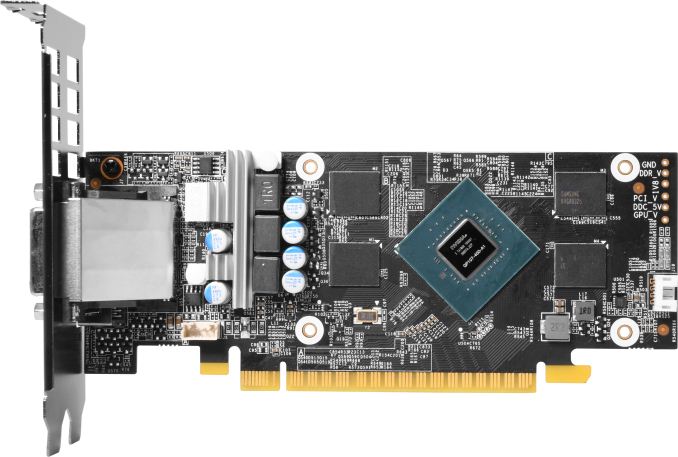GALAX Launches Low Profile GeForce GTX 1050 OC and 1050 Ti OC
by Anton Shilov on February 2, 2017 8:00 AM EST
GALAX has joined the list of manufacturers to offer low-profile video cards based on NVIDIA’s GeForce GTX 1050-series GPUs. The boards resemble similar products from other makers and are designed to upgrade low z-height PCs or build affordable small form-factor HTPCs. As with the other 1050-series parts, these are <75W, meaning no PCIe connector is needed.
The GALAX GeForce GTX 1050 OC LP and the GALAX GeForce GTX 1050 Ti OC LP graphics cards are powered by NVIDIA’s GP107 GPU in different configurations and are equipped with 2 GB and 4 GB of 7Gbps GDDR5 memory respectively. Both add-in-boards use the same PCB design, which the manufacturer is proud of because it uses solid-state coils and has an additional heatsink on the VRM MOSFETs. For the main GPU cooling, the cards also use the same dual-slot dual-fan cooling system featuring an aluminum heatsink with a copper base. As for connectivity, both AIBs have the same set of outputs: one DL-DVI-D, one HDMI 2.0b and one DisplayPort 1.4 with HDCP 2.2 support.
The new low-profile graphics cards from GALAX run ~12 MHz faster than reference designs. The 1% frequency increase does not have any effect on the official power consumption of the cards, so their TDP remains at around 75 W level. They do not need any additional power connectors and can be installed in any modern PC with an open-ended PCIe slot.
| Specifications of Low Profile GeForce GTX 1050-Series Graphics Cards | ||||||||||
| GALAX GeForce GTX 1050 Ti OC LP | GIGABYTE 1050 Ti OC LP 4G |
MSI 1050 Ti LP 4G |
GALAX GeForce GTX 1050 OC LP | GIGABYTE 1050 OC LP 2G |
MSI GTX 1050 LP 2G |
|||||
| SKU | GV-N105TOC-4GL | GV-N1050OC-2GL | ||||||||
| Stream Processors | 768 | 640 | ||||||||
| Texture Units | 48 | 40 | ||||||||
| ROPs | 32 | |||||||||
| Core Clock (MHz) | 1303 | 1303 - 1328 | 1290 | 1366 | 1366 - 1392 | 1354 | ||||
| Boost Clock (MHz) | 1417 | 1417 - 1442 | 1392 | 1468 | 1468 - 1506 | 1455 | ||||
| Memory | Capacity | 4 GB | 2 GB | |||||||
| Type | GDDR5 | |||||||||
| Clock | 7 Gbps | |||||||||
| Bus Width | 128 bit | |||||||||
| Outputs | DisplayPort | 1 × DP 1.4 | ||||||||
| DVI | 1 × DVI-D | |||||||||
| HDMI 2.0b | 1 | 2 | 1 | 1 | 2 | 1 | ||||
| TDP | 75 W | |||||||||
| Launch Date | 1/2017 | 2/2017 | 11/2016 | 1/2017 | 2/2017 | 11/2016 | ||||
GALAX is the third supplier after GIGABYTE and MSI to officially launch low-profile GeForce GTX 1050-series video cards. While demanding gamers hardly pay attention to low-profile cards, these come handy when upgrading low-cost PCs or building miniature HTPCs. The GP107 chip supports DirectX 12, Vulkan, and has an advanced media playback engine that features hardware-accelerated decoding and encoding of H.265 (HEVC) video.
As reported previously, considering the positioning of the GeForce GTX 1050-series products, it unlikely that the new cards from GALAX will cost significantly more than NVIDIA’s MSRPs for similar video cards: $139 for the GTX 1050 Ti and $109 for the GTX 1050. Meanwhile, it remains to be seen when are we going to see the low-profile GALAX cards in the US. Right now the company’s online store as well as Amazon.com do not have them for sale. Since the GALAX brand belongs to Palit Microsystems, low-profile GeForce GTX 1050-series graphics cards from this manufacturer may emerge under different trademarks in different parts of the world (e.g., Gainward or KFA2 in Europe).
Related Reading:
Source: GALAX


















20 Comments
View All Comments
SharpEars - Thursday, February 2, 2017 - link
Taking up two slots - the new low profile! Who cares if it's not as tall...BrokenCrayons - Thursday, February 2, 2017 - link
At 75W TDP its not exactly a good candidate for low profile systems anyway. Rumors have circulated about an as-yet-unreleased GeForce 1040 that might be a better option for those with the patience to wait (gambling on rumors) but currently the only good option for a half-height single slot discrete GPU is the GeForce GT 730 which is generations old and arguably has trouble competing with modern Intel integrated graphics.The lack of reasonable TDP and video card physical sizes was a big reason for me to dump PC gaming and make a move to handheld consoles. My PC can literally be any old pile of underpowered budget trash now so in a way, I've benefited greatly from being forced to move on.
Samus - Thursday, February 2, 2017 - link
True, but there have been low profile single slot quadros that use a mini blower design instead of axial fans. The blowers are more industrial and reliable, so you'd expect them on an expensive card like a quadro or fireGL and unlikely to make the cut list in a $100 part like this.BrokenCrayons - Thursday, February 2, 2017 - link
The problem isn't just expense of the cooler. I agree, a copper cooler with a blower just isn't practical in sub-$100 graphics cards. However, that sort of cooling capacity might be necessary given the TDP that nvidia was targeting which puts OEMs in a bind when it comes to making a cost-effective, lower end card. I don't really get what NV was trying to accomplish with Pascal by raising TDP (or failing to lower it) in each resepctive performance class of their current generation GPUs.Fanboy Disclaimer: Yes, I'm aware AMD's TDP is comparable and the performace with the RX line is lower. They're not the company in being discussed and dragging them into this is off-topic...yet here I am preemptively addressing the matter because I simply see no way for it not to come up. Sheesh, brand loyalists...find a better way to spend your time that doesn't involve waving a company's banner without even having a financial interest in the whole thing.
DanNeely - Thursday, February 2, 2017 - link
The TDPs are probably down to a combination of the new process not being as optimized, and prioritizing performance targets over thermal ones. Relative FPS performance vs the price equivalent AMD card is more important for overall sales than the TDP relative to the previous generation.peterfares - Thursday, February 2, 2017 - link
You stopped PC gaming because you wanted a low-profile single-slot card that was powerful and had little TDP? Why on earth do you have that kind of requirement? And moving to handheld gaming because you couldn't find something? That makes no sense.BrokenCrayons - Thursday, February 2, 2017 - link
The Nintendo DS has been a fantastic alternative and I just picked up a PS Vita recently because I think a Sony-branded product helps onlookers understand I can afford one and that makes me clearly a member of the social elite. (Is that enough tongue-in-cheek elitism for you, fanofanand? *smirk*)No really though, ditching PC gaming wasn't JUST due to GPUs not fitting a form factor and TDP envelope that I found acceptable. Yes, it played a big role in the happy day I heaved my gaming PC over to the ecycler, dusted off my hands, and walked away a happier person. There was a lack of desire to continue using Windows as a primary computer operating system too due to the telemetry and data mining. Linux gaming's come along nicely, but it's still a pain in my awe-inspiring behind so I'm happy to just use my Linux stuff for movies, e-mail, and creative writing. Some more idealistic person with more free time can struggle with that disaster. Then there's the on-going bother of getting new GPUs, processors, motherboards, and whatever other girly-esque accessories are necessary to fit the stupid "gamer" criteria that's discouraging. And, despite my obvious elitism, I despise the PC Master Race silliness that a small number of computer owners insist on touting to make themselves feel like the time they waste on thermal compound research and driver modding was all worth it for that oh-so-critical little nudge of the draw distance slider. And, of course, I was really looking to simplify my entertainment by removing concerns about the underlying platform from the equation and doing so in a manner that makes that entertainment even more portable than a laptop. Furthermore, I don't care much for adding heat to my home in the summer by running some thermal atrocity of a gaming system. Even fairly capable laptops dump considerable waste heat these days. It's inexcusable that a PC can't be both amusing and require nothing but passive cooling at this point. In my mind, technology really has gone the wrong direction as far as power and cooling is concerned (though arguably the Nintendo Switch with its active cooling fan is just as guilty, but I don't see myself purchasing one, partly over the cooling fan business.). Thanks to handheld consoles like the DS (various iterations) and Vita, I'm happy to say the mission is accomplished.
Meteor2 - Friday, February 3, 2017 - link
TL;DR.webdoctors - Wednesday, February 8, 2017 - link
Two things:I've been gaming on Linux for years, its not bad now. You have to have an Nvidia graphics card, and the selection of games is limited but there's enough AAA titles out there that you won't get bored playing solely native Linux games.
The heat issue is negligible for a sub 100W graphics card. That's a single old school light bulb. I had a Radeon 4890HD, now that thing pumped out heat and noise. It was a full 130+W of extra power at the outlet. Modern graphics cards are pretty good efficiency wise.
HomeworldFound - Thursday, February 2, 2017 - link
So two handhelds, one that's completely dead and another that's three generations behind now, instead of PC gaming. That makes a lot of sense for people reading an article about a graphics card for the PC platform.. to you know.. play PC games.